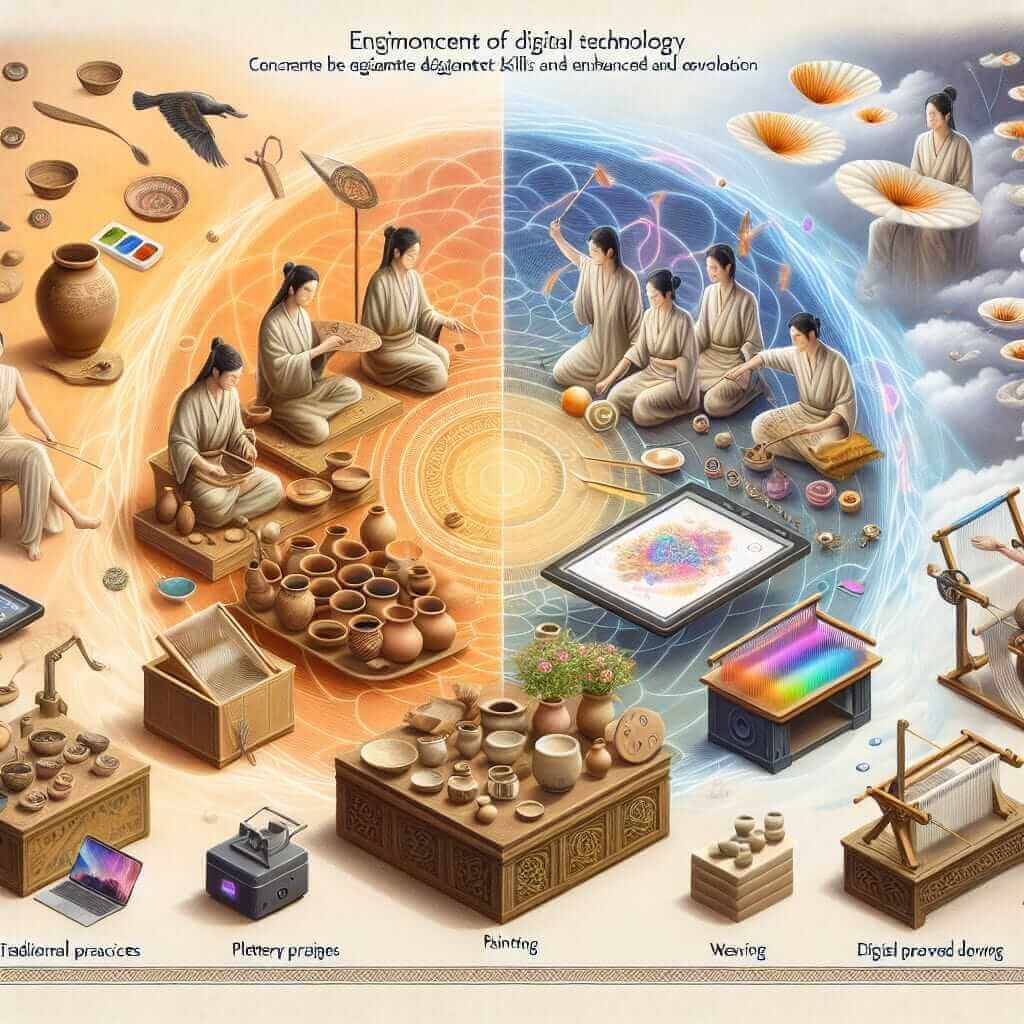The Reading section of the IELTS exam is designed to test your ability to understand and interpret text written in English. It consists of three long reading passages extracted from books, journals, magazines, and newspapers, covering a variety of academic topics. One of the subjects that has garnered considerable attention in recent IELTS exams, and is likely to appear in future tests, is the “Cultural impacts of digital transformation on traditional practices.” This topic represents an amalgamation of current technological advancements and their significance on traditional cultures, which is very relevant today.
Analyzing past IELTS reading exams, themes surrounding digital transformation and cultural impacts have been recurring. Hence, it’s highly beneficial for IELTS examinees to practice reading passages related to this subject.
Reading Passage
Cultural Impacts of Digital Transformation on Traditional Practices
Digital transformation, the integration of digital technology into all areas of business and everyday life, is significantly altering traditional practices. From business processes to cultural rituals, digital transformation brings myriad impacts—both positive and negative.
Digital Preservation and Innovation
One of the most notable impacts of digital transformation on culture is the preservation and modernization of traditional practices. For instance, digital archives now safeguard intangible cultural heritage, allowing future generations to access traditional knowledge with a mere click. Additionally, digital tools are fostering innovation within traditional crafts and practices. Artisans employ 3D printing for intricate designs, thereby blending old skills with new technology to enhance and preserve their craft.
Shift in Social Interactions
Digital platforms have concurrently reshaped how cultural communities interact and maintain their traditions. Social media platforms, for example, have enabled community members dispersed globally to maintain strong cultural ties. Virtual celebrations of festivals and rituals are becoming commonplace, fostering inclusivity and participation among members who are geographically separated. Nevertheless, this digital shift has also led to the dilution of some practices, overshadowed by the prevalence of digital trends.
Economic Impacts on Cultural Practices
Economically, digital transformation has opened avenues for traditional practitioners to reach a broader audience. E-commerce platforms allow artisans to sell their goods globally, fostering economic sustainability of traditional crafts. However, this economic boon comes with challenges. The commodification of cultural artifacts can lead to the commercialization and consequently the potential misrepresentation or degradation of their cultural value.
Preservation vs. Cultural Erosion
While digital transformation aids in the preservation of cultures, it concurrently risks cultural erosion. Younger generations, engrossed with digital trends, occasionally eschew traditional practices, perceiving them as obsolete. The cultural disconnect exacerbates when the younger demographic fails to find relevance in their heritage, leading to a gradual fading of traditional practices.
Questions
Multiple Choice
-
Digital transformation is…
a. Preventing any cultural changes from taking place.
b. Blending old skills with new technology.
c. Resulting in the closure of traditional businesses.
d. Opposing innovation within traditional crafts. -
Which of the following is NOT an impact of digital transformation on social interactions?
a. Enabling virtual celebrations.
b. Dilution of some traditions.
c. Geographic separation of communities.
d. Enhanced inclusivity and participation.
Sentence Completion
- Digital archives help in the __ of intangible cultural heritage.
- Virtual celebrations foster __ among geographically separated community members.
True/False/Not Given
- Digital tools have no impact on the preservation of traditional crafts. (True/False/Not Given)
- Social media platforms have diluted cultural practices among community members. (True/False/Not Given)
Answer Keys and Explanation
Multiple Choice
- b. Blending old skills with new technology.
- Explanation: The passage indicates that digital tools are employed to enhance and preserve traditional crafts by blending old skills with new technology.
- c. Geographic separation of communities.
- Explanation: The passage discusses how digital platforms mitigate the effects of geographic separation, allowing dispersed community members to interact and maintain strong cultural ties.
Sentence Completion
- preservation
- Explanation: Digital archives play a crucial role in safeguarding intangible cultural heritage for future generations.
- inclusivity
- Explanation: Virtual celebrations promote inclusivity and participation among members who are separated geographically.
True/False/Not Given
- False
- Explanation: The passage clearly states that digital tools contribute to the preservation and enhancement of traditional crafts.
- True
- Explanation: The passage notes that while digital platforms enable community interaction, they also lead to the dilution of some traditions.
Common Mistakes and Tips
Common Mistakes:
- Misinterpreting the essence of the passages due to similar terminologies.
- Overlooking small yet significant details that change the context of the information.
- Not managing time efficiently to answer all questions within the given period.
Tips:
- Carefully read the entire passage before answering the questions.
- Pay attention to keywords that can assist in locating exact information.
- Practice summarizing paragraphs to enhance comprehension and retention.
Vocabulary
- Intangible (adj) [ɪnˈtæn.dʒə.bəl]: Unable to be touched or grasped; not having a physical presence.
- Erosion (n) [ɪˈroʊ.ʒən]: The gradual decline or destruction of something.
- Commodification (n) [kəˌmɑːdɪ.fɪˈkeɪ.ʃən]: The action or process of treating something as a mere commodity.
Grammar Focus
-
Relative Clauses: “which,” “that,” and “who.”
- Example: Digital platforms, which connect global communities, have reshaped how traditions are maintained.
-
Passive Voice: Used frequently in formal writings.
- Example: “Digital archives are being utilized to preserve intangible cultural heritage.”
Advice for Higher Reading Scores
- Habitual Reading: Regular reading of diverse materials such as academic journals, magazines, and newspapers.
- Timed Practice: Simulate exam conditions to improve time-management skills.
- Note-taking: Develop the habit of jotting down key points and summarizing paragraphs to enhance comprehension.
- Vocabulary Building: Consistently learn and review new words, especially academic vocabulary.
- Review and Learn: Regularly review mistakes and learn from them to avoid similar errors in future attempts.
For more insights, you can also read about cultural impacts of digital communication and the influence of the internet on global cultures.
 Cultural impacts of digital transformation on heritage
Cultural impacts of digital transformation on heritage
By adhering to these strategies and continually practicing, you’ll undoubtedly enhance your reading skills and perform better in the IELTS exam. Good luck!

